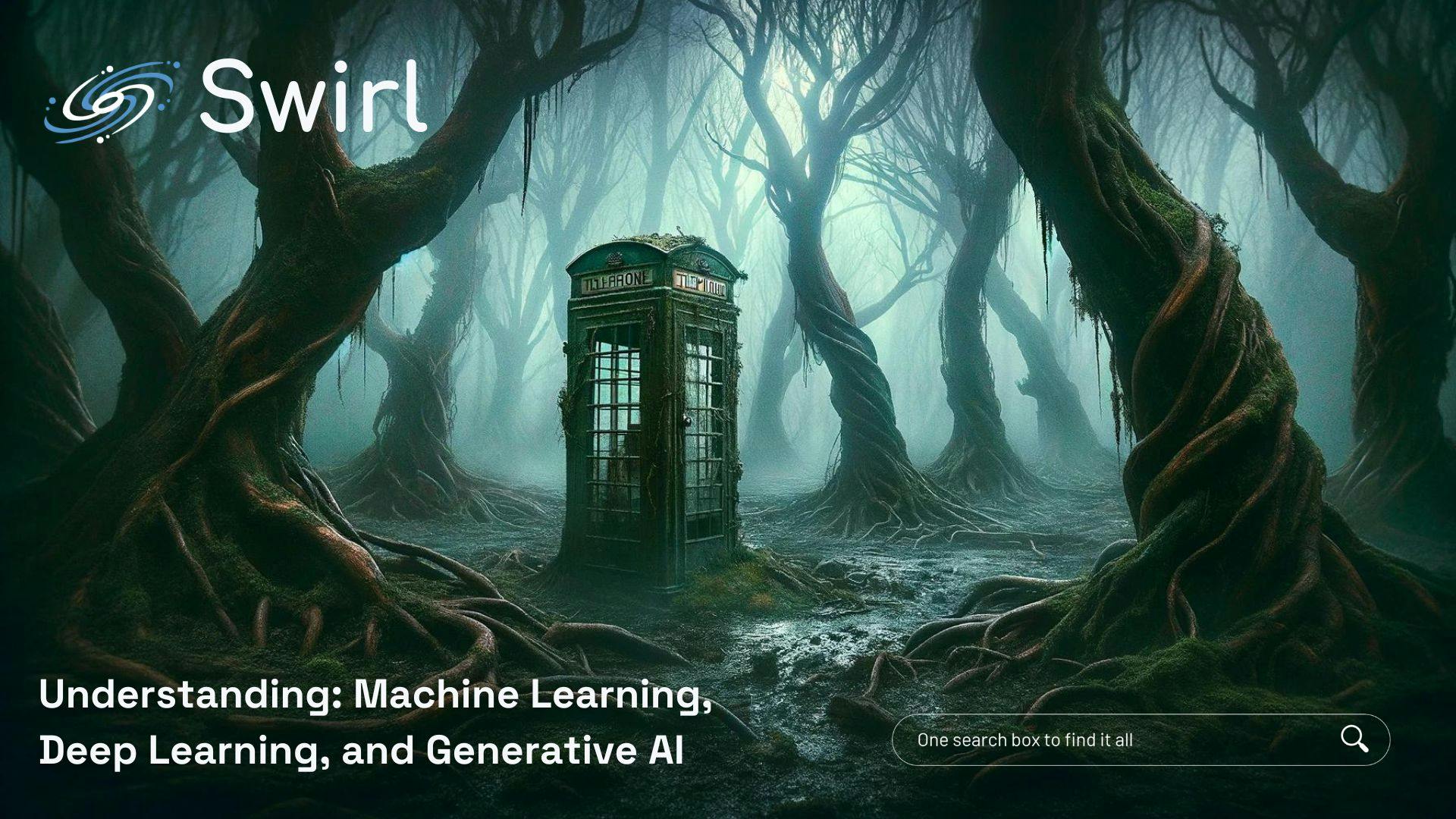Understanding Generative AI, Machine Learning, and Deep Learning

Artificial Intelligence (AI) continues to transform our world incredibly. The concepts of Generative AI, Machine Learning, and Deep Learning are fueling an explosion of exciting possibilities, yet some clarification about how they relate and differ may persist. Let’s break down these powerful branches of AI to get a clearer picture.
Generative AI
Generative AI refers to artificial intelligence capable of creating original content. Unlike most AI systems trained to complete narrow tasks, generative AI can produce outputs that mimic human creativity.
The most popular form of generative AI is the generative adversarial network (GAN). GANs utilize two neural networks – a generator and a discriminator – which compete against each other to become progressively better at their tasks. The generator creates new samples (images, text, etc) to fool the discriminator, while the discriminator attempts to identify which samples are artificial and which are real. This adversarial training enables GANs to generate strikingly realistic and novel content.
Generative AI has exploded in popularity in recent years. Applications include:
- Text generation: Apps like Anthropic’s Claude can craft human-like text on demand.
- Image generation: DALL-E 2 by OpenAI can create images from text captions.
- Video generation: Models like GoNets generate artificial talking head videos.
- Music generation: Jukebox by OpenAI can compose instrumentals and vocals.
A key advantage of generative AI is its versatility. While most AI is narrow in scope, generative models can synthesize content across different formats, from text to image to audio. This makes generative AI more akin to human creativity.
Machine Learning
Machine learning is a subset of AI that trains algorithms to make predictions or decisions without explicit programming. The “learning” comes from feeding data to algorithms, allowing them to recognize patterns and refine their output.
For example, a machine learning algorithm can be trained on thousands of X-ray images to detect signs of lung cancer. By analyzing the dataset, the algorithm learns to recognize visual patterns indicative of malignancies. This enables it to diagnose new X-rays it hasn’t encountered before.
Fundamental machine learning approaches include:
- Supervised learning: Models are trained on labeled datasets, giving feedback on predictions. Familiar with classification and prediction tasks.
- Unsupervised learning: Models must find patterns in unlabeled, uncategorized data. Used in clustering and association mining.
- Reinforcement learning: Models learn through trial-and-error interactions with environments. Behind gaming AIs and robotics.
Machine learning powers everything from product recommendations to financial fraud detection. It excels at pattern recognition at scale. However, machine learning models are confined to narrow domains defined by their training data and lack generative abilities.
Deep Learning
Deep learning is a sophisticated machine learning approach based on artificial neural networks. Inspired by the biological neural networks in brains, these artificial networks contain layers of interconnected nodes like neurons. Data flows through the nodes, with each layer detecting different features.
What makes deep learning “deep” is the number of layers in its neural networks. While a typical machine learning algorithm may utilize a shallow neural net with a few layers, deep learning networks can have hundreds of layers. These large networks can identify highly abstract patterns and concepts necessary for complex tasks.
Three major architectures under the deep learning umbrella are:
- Convolutional Neural Networks (CNN): Powerful for image and video recognition. CNN layers detect visual features like edges, textures, and objects.
- Recurrent Neural Networks (RNN): Useful for sequential data like text and audio. RNNs maintain context across data sequences.
- Transformers: Attention-based networks strong in language-related tasks. Notable for powering chatbots and language translation.
Deep learning has been behind significant AI achievements like AlphaGo beating world champions at Go and AI systems surpassing human baselines in object recognition. With its hierarchical feature extraction abilities, deep learning takes machine learning to a new level of sophistication.
How Does Machine Learning, Deep Learning, and Generative AI Work?
- Machine Learning: ML comes in diverse forms. In ‘supervised’ ML, algorithms are given labeled data to train on. Imagine feeding an ML model many pictures labeled ‘cat’ or ‘dog.’ It learns to recognize features defining each category. When it sees a new, unlabeled image, it can classify it with increased accuracy. Other ML types, like ‘unsupervised’ learning, find patterns in unlabeled data, and ‘reinforcement learning’ optimizes decision-making through rewards and penalties.
- Deep Learning: Powered by large neural networks, DL systems handle high-dimensional, complex data, like images, videos, and language. A significant leap lies in their ability to self-improve by adjusting themselves during training. Think of the ‘cat’ versus ‘dog’ example on a vastly larger scale; a DL system iteratively strengthens its internal parameters with exposure to massive datasets, allowing it to discern finer and finer distinctions.
- Generative AI: This revolutionary offshoot of DL centers on creation. Generative AI algorithms are trained on enormous data sets and learn the underlying patterns, enabling them to produce text, images, music, code, and more. Picture an AI painter, having analyzed thousands of artworks, generating‘’ ’stunning pieces in different styles.
Some Examples of Machine Learning, Deep Learning, and Generative AI
- Machine Learning
- Spam filters identify suspicious emails based on patterns.
- Recommendation engines suggest what to watch, shop for, or read based on your past preferences.
- Fraud detection systems discover out-of-the-ordinary financial transactions.
- Deep Learning
- Self-driving cars use images to make real-time decisions about navigation.
- Facial recognition technology unlocks your phone or tags you in photos.
- Medical image analysis aids diagnosis with a greater degree of accuracy.
- Generative AI
- Chatbots like ChatGPT offer conversation and provide tailored content.
- Image generators like DALL-E 2 produce images based on simple text descriptions.
- AI can compose musical pieces inspired by your favorite composers.
Key Differences
While generative AI, machine learning, and deep learning share the common goal of constructing intelligent systems, summarizing their key differences helps provide clarity:
- Generative AI specializes in creating novel, original content that mimics human creativity. Machine learning and deep learning focus on analysis and pattern recognition.
- Machine learning utilizes simple neural network architectures compared to deep learning’s complex neural networks with abundant layers.
- Deep learning achieves state-of-the-art results across speech, visual, and language domains – outperforming other approaches. Machine learning is more general purpose.
- Machine learning algorithms require careful feature engineering and data preprocessing from human experts. Deep learning automates feature extraction through hierarchical learning.
- Generative AI produces strikingly realistic synthetic content, from writing to art. Machine learning and deep learning do not have generative capabilities. Generative AI also requires substantial data to generate convincing outputs but focuses on creativity rather than prediction or classification.
Key Difference between Machine Learning, Deep Learning, and Generative Artificial Intelligence Visualized.

Conclusion
AI is transforming society through generative models producing original content, machine learning algorithms capable of processing massive datasets, and deep learning networks matching or exceeding human performance on complex cognitive tasks.
